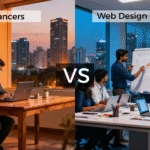Web Development
Web development is the work involved in developing a website for the Internet (World Wide Web) or an intranet (a private network). Among Web professionals, “web development” usually refers to the main non-design aspects of building Web sites: writing markup and coding.
Web Development Courses
You can learn some popular languages and programs that are listed below:
HTML5
HTML5 is a markup language used for structuring and presenting content on the World Wide Web. It is the fifth and last major HTML version that is a World Wide Web Consortium (W3C) recommendation. HTML 5 is intended to subsume not only HTML 4 but also XHTML 1 and DOM Level 2 HTML.
CSS3
Cascading Style Sheets Level 3 (CSS3) is the iteration of the CSS standard used in the styling and formatting of Web pages. CSS3 incorporates the CSS2 standard with some changes and improvements.
JavaScript
JavaScript is a text-based programming language used both on the client-side and server-side that allows you to make web pages interactive.
Bootstrap 4
Bootstrap 4 is a free and open-source front-end development framework for the creation of websites and web apps. It is the most popular HTML, CSS, and JavaScript framework for developing responsive, mobile-first websites.
DOM Manipulation
When writing web pages and apps, one of the most common things you’ll want to do is manipulate the document structure in some way. This is usually done by using the Document Object Model (DOM), a set of APIs for controlling HTML and styling information that makes heavy use of the Document object.
NPM
NPM is the package manager for the Node JavaScript platform. It puts modules in place so that node can find them, and manages dependency conflicts intelligently. It is extremely configurable to support a wide variety of use cases. Most commonly, it is used to publish, discover, install, and develop node programs
Node.js
Node. js is a platform built on Chrome’s JavaScript runtime for easily building fast and scalable network applications. It is an open-source, cross-platform, back-end JavaScript runtime environment that runs on the V8 engine and executes JavaScript code outside a web browser.
MongoDB
MongoDB is a source-available cross-platform document-oriented database program. It is used for high volume data storage.
REST
Representational state transfer (REST) is a software architectural style that was created to guide the design and development of the architecture for the World Wide Web.
Express
Express is a popular unopinionated web framework, written in JavaScript and hosted within the Node. Js runtime environment. This module explains some of the key benefits of the framework, how to set up your development environment and how to perform common web development and deployment tasks.
ES6
ES6 or ECMAScript 2015 is an ECMAScript Language Specification standard that defines the standard for the implementation of JavaScript. It brings new syntax and new awesome features to make your code more modern and more readable.
Web Development Languages
Some best web development languages are listed below:
JavaScript
JavaScript, often abbreviated JS, is a programming language that is one of the core technologies of the World Wide Web. JavaScript gives web pages interactive elements that engage a user.
Java
Java is a simple, efficient, general-purpose language. Java was originally designed for embedded network applications running on multiple platforms
HTML
HyperText Markup Language or HTML is the standard markup language for documents designed to be displayed in a web browser. Here the content could be structured within a set of paragraphs, a list of bulleted points, or using images and data tables.
CSS
Cascading Style Sheets (CSS) is a style sheet language used for describing the presentation of a document written in a markup language such as HTML. It is used to style and layout web pages. For example, to alter the font, color, size, and spacing of your content, split it into multiple columns, or add animations and other decorative features.
React
React is a component-based JavaScript frontend library that is used to build the user interface especially for Single Page Applications (SPA). React js is not only used for web development, but you can also develop Mobile Apps, Desktop Apps, Virtual reality Apps, and many more.
Angular
Angular is a structural framework for dynamic web applications. It lets you use HTML as your template language and lets you extend HTML’s syntax to express your application components clearly and succinctly. Its data binding and dependency injection eliminate much of the code you currently have to write.
Objective C
Objective-C is a general-purpose, object-oriented programming language that adds Small talk-style messaging to the C programming language.
Scala
Scala is a strong statically typed general-purpose programming language that supports both object-oriented programming and functional programming.
Python
Python is a computer programming language often used to build websites and software, automate tasks, and conduct data analysis. Python is a general-purpose language, meaning it can be used to create a variety of different programs and isn’t specialized for any specific problems
C#
C# (pronounced “See Sharp”) is a modern, object-oriented, and type-safe programming language. C# can be used to create a number of different programs and applications: mobile apps, desktop apps, cloud-based services, websites, enterprise software, and games.
C++
C++ is a general-purpose programming language. It can be used to create high-performance applications.
PHP
PHP (Hypertext Preprocessor) is known as a general-purpose scripting language that can be used to develop dynamic and interactive websites. It was among the first server-side languages that could be embedded into HTML, making it easier to add functionality to web pages without needing to call external files for data.
Web Development Jobs
Applications developer
An application developer is a critical part of technical and/or project management teams responsible for ensuring user needs are met through the deployment and updates of software. The application developer could be responsible for working with a team to deploy releases to internal or external clients.
Game developer
Game developers take a designer’s concepts and build them into a playable game for users. Game developers, also known as game programmers, write code for games for a variety of formats, such as PCs, consoles, web browsers, and mobile phones.
Multimedia programmer
Multimedia programmers are responsible for designing and creating multimedia computer products that combine text with sounds, pictures, graphics, video clips, virtual reality, digital animation, and other forms of media.
Multimedia specialist
Multimedia specialists create computer animation, audio, video, and graphic image files for multimedia applications. Multimedia specialists plan, produce, and maintain websites and web applications using web programming, scripting, authoring, content management, and file transfer software.
SEO specialist
A Search Engine Optimization or SEO Specialist tests analyzes and changes a website so it is optimized for search engines, and the website subsequently ranks higher in the search results on major search engines such as Google and Bing.
UX designer
UX designers conduct user research, design, write UX copy, validate/test with users and sell/present the design solution to the business. It’s the UX designer’s role to be the voice of the user and advocate for the user’s needs while balancing the business goals.
UX researcher
UX researchers systematically study target users to collect and analyze data that will help inform the product design process. That’s where user experience (UX) research comes in. UX researchers systematically study target users to collect and analyze data that will help inform the product design.
Web content manager
A Web Content Manager writes, proofreads, and edits content; develops and manages an editorial calendar to ensure timely content; and, collaborates with marketing and design teams to ensure consistent brand messages across all channels.
Web Development Company
The primary scope of work for a web development company in Bangalore includes ideating, designing, creating, and maintaining websites and applications.
Ideating
It is the process of generating a broad set of ideas on a given topic, with no attempt to judge or evaluate them. At this stage, the focus is on the number of ideas rather than quality. Thus in this process, the company generates ideas for the development of your website and its content.
Designing
The company plans to create and codes web pages, using both technical and non-technical skills to produce websites that fit your customers’ requirements. Being involved in the technical and graphical aspects of pages, you’ll determine not only the look of the website but how it works as well.
Creation of Website
Listed below is a step-by-step guide that companies employ for the creation of a successful business website.
- Determine the primary purpose of your website.
- Decide your domain name.
- Choose a web host.
- Build your pages.
- Set up your payment system.
- Test and publish your website.
- Market your website on social media.
Maintaining Websites
Website maintenance is the process of checking to see whether your website is healthy and performing well. It’s about keeping up with security updates, fresh content, encouraging traffic growth, and making sure your website visitors are happy. Thus they will perform such tasks to make your business successful.
Best Web Development Company
The Best Website Development Company Employs 7 Steps, From Planning to Launching:
Stage 1: Defining the Project
They will define your project by understanding the needs of your customers and making your website user-friendly.
Stage 2: Plan Your Website
They will plan your website by determining the primary process of the website; they will decide your domain name, choose a web host and then build your pages.
Stage 3: Design Your Website
They will design your website to engage more visitors by making it more interactive.
They will use pictures and videos on your website.
Stage 4: Create Content
They will create highly valuable content for your website.
Stage 5: Develop Your Website
They will develop your website on a regular basis to match the day-to-day life needs of customers.
Stage 6: Test Your Website
They will check the below parameters.
Secured and reliable website (and that includes the utilization of HTTPS)
Mobile responsiveness
Fast website load speed
Stage 7: Maintain Your Website
They will maintain your website whether it is healthy and performing well. Also encouraging traffic growth and making sure your website visitors are happy.















